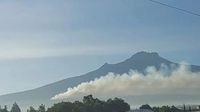As wildfires continue to rage across Mexico, the state of Tlaxcala is grappling with a significant environmental crisis. As of April 13, 2025, the nation is facing 115 active forest fires, with 46 of them under significant control, according to the National Coordinator of Civil Protection, Laura Velázquez Alzúa, during a press briefing. Among these, Tlaxcala has recorded 28 forest fires this year, predominantly affecting the Natural Protected Area of La Malinche.
Reports indicate that the flames are not only devastating local ecosystems but also impacting air quality across neighboring regions. The skies in Puebla have turned an alarming shade of orange due to smoke from these fires, particularly those near the La Malinche volcano. The Cerro de San Gabriel in Atltzayanca is one of the areas hardest hit, with flames consuming both flora and fauna.
In addition to Atltzayanca, fires have also been reported in San Bartolomé Cuahuixmatlac, Santa Ana Chiautempan, and the municipality of Libres in Puebla. The situation has prompted health authorities in Huamantla to recommend that residents stay indoors and wear masks to mitigate the effects of smoke inhalation.
As the situation escalates, a coordinated effort involving multiple agencies is underway to combat the blazes. Brigadistas from the National Forestry Commission (CONAFOR), National Defense, National Guard, Navy, and local volunteers are working tirelessly to extinguish the fires. Currently, 49 brigades are engaged in evaluating and combating the wildfires, with particular focus on the areas surrounding La Malinche.
Laura Velázquez Alzúa noted that the ongoing drought conditions are exacerbating the wildfire crisis. From January 1 to April 6, 2025, the country has received only 41.3 millimeters of rainfall, a significant 32.7 percent deficit compared to historical averages from 1991 to 2020. As of March 31, 2025, approximately 42.8 percent of Mexico's territory is classified under moderate to exceptional drought conditions, with the northern and northwestern regions being the most severely affected.
This lack of moisture not only increases the risk of ignition but also fuels the intensity and rapid spread of the fires, raising alarms among authorities. The situation in Tlaxcala has positioned the state as the 17th highest in the country for the number of fires attended in 2025, with 53 percent of the incidents occurring within La Malinche.
Between March 28 and April 3, 2025, Tlaxcala reported four significant incidents, impacting 9.09 hectares of land, predominantly affecting herbaceous vegetation. The fires pose a serious threat to both the natural environment and public health, as the smoke has resulted in poor air quality across the region.
The Secretariat of the Environment in Puebla has issued warnings regarding the effects of the ocher sky, attributing it to a combination of high ozone levels, particulate matter (PM2.5 and PM10), humidity, and solar radiation mixing with smoke from the ongoing fires. Health officials recommend that residents limit their outdoor exposure and wear masks to protect against harmful air pollutants.
The combination of these factors underscores the urgent need for a concerted response to manage the wildfires and mitigate their impact. As the situation develops, authorities are working diligently to contain the fires and protect both human health and the environment.
In the face of this crisis, the collaboration between various levels of government, emergency services, and community volunteers highlights the resilience and determination of those affected. However, as the drought continues and fire conditions worsen, the need for sustainable environmental management and proactive measures becomes increasingly clear. The ongoing situation serves as a stark reminder of the challenges posed by climate change and the importance of preparedness in the face of natural disasters.






